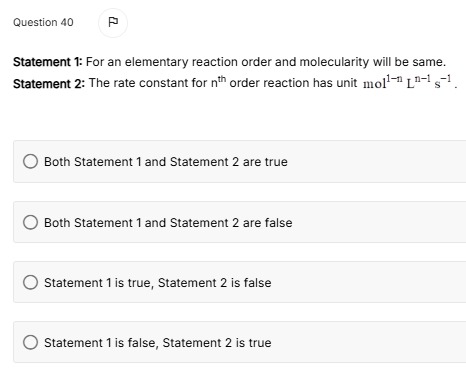Question
Question: Statement 1: For an elementary reaction order and molecularity will be same. Statement 2: The rate c...
Statement 1: For an elementary reaction order and molecularity will be same. Statement 2: The rate constant for nth order reaction has unit mol1−n Ln−1 s−1.

Both Statement 1 and Statement 2 are true
Both Statement 1 and Statement 2 are false
Statement 1 is true, Statement 2 is false
Statement 1 is false, Statement 2 is true
Both Statement 1 and Statement 2 are true
Solution
Statement 1: For an elementary reaction, order and molecularity will be the same. An elementary reaction is a reaction that occurs in a single step. The molecularity of an elementary reaction is defined as the number of reactant species (atoms, molecules, or ions) that collide simultaneously to bring about the chemical reaction. The order of a reaction is the sum of the exponents of the concentration terms in the rate law. For an elementary reaction, the rate law can be written directly from the stoichiometry of the balanced chemical equation, where the exponents of the concentration terms are equal to the stoichiometric coefficients of the reactants. Since molecularity is also determined by the number of reactant species involved in the elementary step, which corresponds to the sum of the stoichiometric coefficients, for an elementary reaction, the order is equal to its molecularity.
For example, if an elementary reaction is A + B → Products, the molecularity is 2. The rate law is Rate = k[A]1[B]1, so the order is 1 + 1 = 2. Thus, order = molecularity = 2.
If an elementary reaction is 2A → Products, the molecularity is 2. The rate law is Rate = k[A]2, so the order is 2. Thus, order = molecularity = 2.
In general, for an elementary reaction, order = molecularity. Therefore, Statement 1 is true.
Statement 2: The rate constant for nth order reaction has unit mol1−n Ln−1 s−1. The rate of a reaction is typically expressed in units of concentration per unit time, such as mol L−1 s−1.
For an nth order reaction, the general rate law is given by:
Rate = k [Concentration]n
Let's consider the typical units:
Rate unit = mol L−1 s−1
Concentration unit = mol L−1
Substituting these units into the rate law equation:
mol L−1 s−1 = (Unit of k) × (mol L−1)n
mol L−1 s−1 = (Unit of k) × moln L−n
To find the unit of k, we rearrange the equation:
Unit of k = moln L−nmol L−1 s−1
Unit of k = mol1⋅ mol−n⋅ L−1⋅ L−(−n)⋅ s−1
Unit of k = mol1−n⋅ L−1+n⋅ s−1
Unit of k = mol1−n Ln−1 s−1
This matches the unit given in Statement 2. Therefore, Statement 2 is true.
Since both Statement 1 and Statement 2 are true, the correct option is the one stating that both statements are true.
